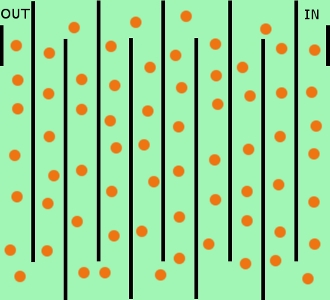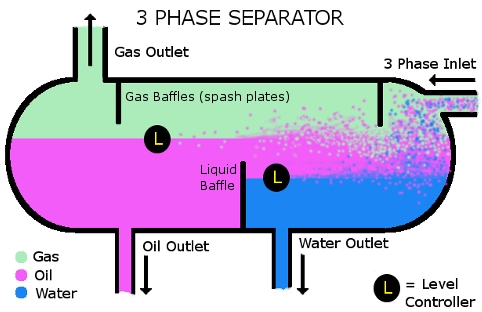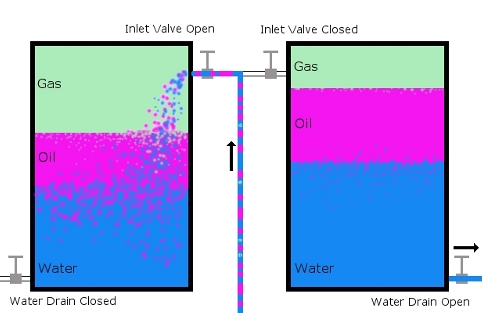Boomers! I'm going to be on Virtually Speaking with host Jay Ackroyd and fellow-guest Riki Ott! We'll be on July 8th at 6:00 PM Pacific, 9:00 PM Eastern.
BlogTalkRadio
Also HERE
There'll be a podcast available for those who want to listen later. We'll also be on Second Life. I've never done Second Life, so if my avatar scratches his balls or struts around squawking like a huge ckicken or starts humping Jay Ackroyd's leg... please forgive me. I'm really nervous about fat-fingering the Second Life controls.
The most popular feature of my diaries here has always been my explanations of oil and gas technology and processes. Today, I'm going to talk about gas, oil and water separation. It's something I actually know a lot about. Let's splash over to the other side of the baffle.
Product coming from a well, a pump or a skimmer is very commonly all jumbled up. This is what is called three-phase flow -- the three unseparated phases being gas, oil and water. Water is easy. Gas and oil will change phases readily with changes in temperature. For the purposes of my explanations here, we'll be separating the gas and oil at the temperatures we receive them. There are several means of separation. In the oil and gas industry (as well as most other industries or applications) our primary tool is gravity. Next comes collision. Temperature is also used, but we won't address that here... much if at all. The most important variable with gravity separation is retention time. Gravity will cause liquids to sink, heavier liquids to sink more, and gasses to float to the top. Retention time is the amount of time we allow for gravity to do its work. A water glass is a separator. When you fill it at your kitchen sink, you're separating water and air. Try filling it with the nozzle on your garden hose. Not enough retention time!
retention time: the average amount of time between molecules of gas oil or water entering the separation vessel and leaving it.
For any given vessel (separator), gas, oil and water will each have their own retention times. To illustrate retention time, however, let's not talk about petroleum products or water, let's talk about people lining up for rides at the Daily Kos Amusement Park (Havana, Cuba). Because the Great Orange Satan Coaster is one of the busier rides at the Daily Kos Park, we've had to arrange one of those serpentine queue thingys. You'll see these at amusement parks and nowdays, at airports. These things are where you find yourself staring at the same boobs over and over and having the same undisciplined children (future GOP Senators) climb all over your luggage and make faces at you. Here's the Great Satan Coaster queue on a weekday (low pressure).
-

-
Remember, we're not talking about separation right now. Just retention time. It's not a busy day at the Great Orange Satan ride, so people can maintain a little space between themselves. Retention time here is the average time between a person entering the queue on the right and leaving it on the left. What about on weekends when the Great Satan ride gets a lot more riders? What if we want to increase the number of people in the queue, without adding rows to the queue? We increase the pressure. We decrease the distance between people in the queue -- but we increase the retention time. There's only so many cars on the Great Orange Satan Coaster and the ride takes a fixed time.
-

-
So increasing pressure increases retention time! What if we want to increase retention time, without increasing pressure?
-

-
We add more rows. We increase our separator size. Here's a real (but simplified) 3-phase separator:
-

-
Okay, forget about the serpetine queue stuff, that was just a discussion of retention time. Now we've moved on to actual separation, using, primarily, gravity. The only things in this picture that might not be self-explanatory, are the level controllers. Look inside your toilet tank. That's a level controller. The level controllers in an oil and gas separator control dump valves, one each on the oil and water outlet lines.
This is a horizontal separator. Horizontal separators are good for oil wells, because they can handle more liquids without carrying over. Vertical separators are better for gas wells, because they're capable of separating a lighter oil (think lighter than gasoline) without carrying over. Carrying over is when the mixed up, foamy, splashy part on the right of this picture moves far enough to the left to be carried out the gas outlet. This happens when your separator is too small or you're not holding enough pressure. It happens because of a lack of retention time.
If you open a bottle of Diet Coke and leave it to go flat, you're separating (CO2 and water, basically). If you drop the bottle of Diet Coke on the floor and then open it, you're carrying over. Looking at the picture (above) of a 3-phase separator, you can see that the lower right is the water area, the lower left is the oil area and the upper third if the cylinder is the gas area. Let's say we know our well is going to make more water and this is for a permanent installation. We would move the liquid baffle to the left, giving us more water retention time. More oil? we move the liquid baffle to the right. But what if it's temporary, like our present situation, and we just have to take what we can get -- generic separators like this one. What are our means of increasing retention time, generally?
- We can increase the pressure, usually by partially closing a backpressure valve, located on the gas outlet line. BUT! This will cause backpressure on the cap atop the BOP (old #4) and allow us to collect less oil. If we increase pressure as our means of increasing retention time, we won't be taking everything our seafloor configuration will give us!
- WE CAN INCREASE OUR SEPARATOR SIZE! Or, get more separators! With what's a stake here, we can get more separators than we need. We could have a month ago. Right now, they're holding about 1000 psig backpressure at the boat, against the flow from the top of the BOP. To separate and process, with adequate separation (retention time!) they only need to hold about 120 psig. They could be capturing most or all of what is leaking up and around #4 and has been leaking ever since they placed the cap there in the first place.
Why BP Are A Bunch Of Fuckers Here
If you don't separate, you cannot legally measure gas or oil. The estimates from the quasi-official Flow Rate Technical Group will not stand up in court. BP knows this. Our Government knows this. Anything still leaking into the Gulf of Mexico up to the instant they kill the well (which could be soon) is negotiable. Once that negotiation starts, we will be measuring the efficacy of expert witnesses, lawyers and judge-shopping. We will NOT be measuring the amount of oil that has been spilling into the Gulf of Mexico for 80 fucking goddamned days now. Everytime you hear of another delay in capturing, separating and measuring ALL the oil leaking into the Gulf, remember that.
Anything still leaking into the Gulf of Mexico up to the instant they kill the well is negotiable. It makes every drop of oil they've leaked and not measured... NEGOTIABLE! Oh, by the way, the oil and gas they're burning on the Q4000? That's not separated or properly measured. That's an estimate too. That's negotiable.
Up until June 6th, I thought perhaps BP was stalling or incompetent. I wrote a diary about it on June 7th. Now it's July 8th. A month. I no longer suspect incompetence. I suspect stalling. I suspect collusion. I suspect fraud. 24 hours of true separation and measurement is the standard definition of an allocation test -- one that will stand up in court. If BP does not capture ALL the oil and gas from this leak for at least one 24-hour period, separate it and measure it, before the well is killed, Congress MUST subpoena everyone involved and have them testify under oath as to why that did not occur. If we can't nail BP for every drop of oil, let's nail them for something else. Who knew what when -- who said what to who? Who stalled? Why? They can't say it wasn't possible. It was VERY possible.
Liquid Separation: Costner and A Whale
Okay, this part has nothing to do with legal measurement of product. Here we're talking about what to do with what the skimmers collect. Pumpers have been doing this since there have been oil wells. You pump or produce into one tank while allowing the other to settle and drain water.
-

-
Then you switch tanks. Once you've got both tanks, say 70% full and holding mostly oil, it's time to ship oil. As you can see from the left-hand tank, it is possible in some situations to be draining water (at the rate you're producing it) from the same tank you're producing into. Now, granted, the water you're draining may have a little oil in it. Presently, the EPA demands that water drained back into the Gulf, be lower than 15 ppm oil. I think they demand that. I cannot find out. I've asked them if they've waived that rule and they won't say. They won't say they haven't made the decision yet, as they know I could come back with,
"It's been 80 fucking goddamned days! When do you think you might make that decision?"
The EPA just won't say anything. They'll refer you to the Unified Command, who will refer you right back to the EPA... but they won't say shit about shit. Big goddamned National Security secret. Why is it important?
Presently, the only data we've gotten from the testing of Costner's machines tells us those machines get the water down to 80 ppm oil. That's with a lot of other non-Costner process upstream. A Whale, the large foreign-flagged tanker they've been testing probably only gets the water down to 300 ppm or so. Just using tanks, as in the picture above (or a tanker, for that matter), anyone could get the oil in the water down to about 1500 ppm by just using settling time and draining the water.
10,000 ppm is 1%
If they would just change the rule, just for this cleanup, to say that any at-sea process must remove and store 90% of the oil taken in before expelling water, no argument could be made that anything more exotic than a tank with a drain valve is needed. Everyone knows the guys on the barges have been making room by draining water. They're trying to help clean up an oil spill... a big one. Why make them criminals? The whole idea of skimming is to get as much oil off the water you can, before that oil makes it to shore. It's like you have 6000 acres of wheat to get in before a big rain-storm. You skip the field corners and weed patches. You put the combine harvester in high gear, knowing that is going to miss a few percent more of the wheat. If some ridiulous rule is resulting in more oil hitting the shore, that's a problem, and the people who made that rule should have to answer for it.
OR.... is at-sea separation even that important? All this liquid goes to the bad oil tanks at refineries and processing plants. Those can handle ANY amount of water. The skimmers themselves unload to barges and tankers at sea. Has there been a problem? Has there been a lack of tankers and barges? Have any skimmers had to stop work because they have nowhere to unload at-sea? If not, if tankers heading ashore with 80% water isn't a bottleneck in the process, then there's no reason whatsoever for the EPA to waive the 15 ppm rule. If that's so, then Costner's machines are doing essentially nothing as well.
So. News Media! Here's your questions:
- Has there been a lack of tankers and barges?
- Have any skimmers had to stop work because they have nowhere to unload at-sea?
- Is the lack of at-sea oil/water separation a problem for the skimming operations? At all?
- Has the EPA waived or adjusted the 15 ppm rule? Do they even need to?
- Is all of this a big goddamn secret? Why?
---
If anyone wants the real scoop regarding what's happening at the leak site, do what I do: visit the Daily Kos Gulf Disaster Liveblog! The only place I know where someone is ALWAYS watching the leak!
UPDATE: WOWZER! You don't want to miss today's Liveblog Mothership! Our own chem professor (Wee Mama) gives us a lesson in organic chemistry! There is NO PLACE like Daily Kos!
Wee Mama has been a professor of biochemistry at a Big Ten university since 1981. Her research focuses on the cytoskeleton. She has been a Fellow of the American Association for the Advancement of Science since 1994.
Remember the BP Catastrophe Liveblog Mothership - To Keep It Holy
Another Update! Bob Cavnar links me on Huffpo! Looks like we may get some traction on this! Bob had my same suspicions about the same time I did back in June.
---
IMPORTANT NOTE!!! Please do not imbed CNN clips. You may link them, but do not imbed them. They cause trouble with some browsers and prohibit people from commenting. EVERYONE should be able to comment on Daily Kos, regardless of their browser choice.


